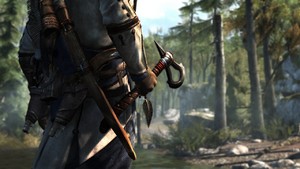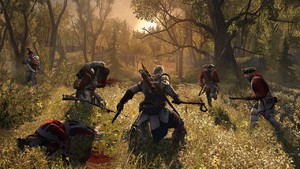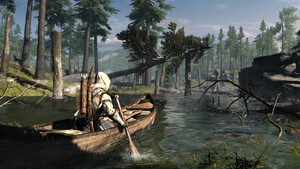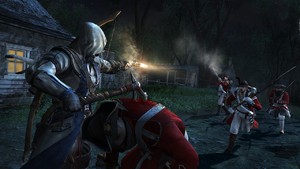
The assassins return for one more stab at the open-world adventure crown, as Ubisoft readies Assassin’s Creed III, a brand new chapter of its time-travelling silent-killing franchise. Eschewing the medieval and Renaissance settings of its predecessors, the game takes place in Colonial America on the brink of the Revolutionary War against the British Empire and features a new protagonist named Connor, a half-British, half-Native American driven by a thirst for justice to his people.
We were recently invited to the official press unveiling of the game in the heart of London with Tommy François, head of IP development at Ubisoft, acting as a droll master of ceremonies. He took us through the game's development process, starting with an early concept video that suggests the last two series releases — Brotherhood and Revelations) were always thought of as iterations of an already established storyline rather than new episodes. Assassin’s Creed III, on the other hand, was intended to leap forward into modern times from the very beginning with the full weight of Ubisoft Montreal and the assistance of eight other studios behind it, making it Ubi’s “biggest game ever”. Twice the production capacity of Revelations, the involvement of developers of the original Assassin’s Creed and the seminal Prince of Persia: The Sands of Time, see that this is the case.
Engine room
A new engine has been built from scratch for Assassin’s Creed III, and while it's not entirely obvious right from the start — more a credit to the overall quality of the series than a complaint — character modelling and animation have clearly improved, with a finesse in hair and clothing detail that comes through particularly well in close-ups and cinematics. François proudly announces that simultaneous voice, face and body motion capture has been employed for the first time in gaming to capture as many nuances as possible, in particular with the main character. A demo video introduces us to Connor, first spotted wistfully glancing into the distance perched between the branches of a snowed tree, but quickly unmasked as a killing machine on the ground. As befits his Native American lineage, he fights using traditional Mohawk weapons, wielding a bow and arrow and tomahawk to deadly effect. François is quickly to point out that, as a descendant of the Assassins, Connor will also share more than a suspiciously trendy hoodie with previous Assassins Altaïr and Ezio, making use of their silent modus operandi too.

If anything about the main character sounds like another turn of a familiar screw, it’s because the most noticeable change in Assassin’s Creed III comes from its settings. The new urban landscapes — Boston and New York “under siege” — move away from the traditional aesthetics and gameplay of the Assassin’s series; a team of six researchers spent the best part of two years ensuring the portrayal of these cities matches the documentation of the era in both looks and feel. While this means they'll be smaller than the Rome or Florence areas of previous games, their expansive layouts result in broader and livelier streets with a plethora of non-playable characters, including domestic animals and children for the first time, making it harder than ever for an assassin to carry out his mission. To counteract this, the Montreal team has boosted the fleeing mechanism by enabling free running and leaps of faith onto moving targets and making use of interiors in a first for the series.
In the demo we saw, Connor escapes from a patrol of soldiers by stepping on a passing carriage, jumping onto a pole and hurling himself into the bedroom of an unsuspecting housewife before exiting via the back window onto a sea of rooftops. It's a staged set-up — the woman happens to slam open the window shutters of the house the very moment Connor runs towards them — but it brings an added touch of unpredictable interaction to a city life that has in the past felt either too reactive to the player’s actions or trapped in its own action bubble. François announces that this time NPCs will have stronger interactions with each other regardless of the player’s actions: we saw a thief stealing some fruit from a grocer’s stall right in front of Connor’s eyes, but we're free to choose whether to intervene or not. François also repeatedly stressed the importance of the metropolises as “independent characters in the story” with their unique idiosyncrasies.
Frontier man

But whereas the city maps ultimately feel like a finely-tuned evolution of one of the strengths of the series, Assassin’s Creed III biggest environmental shake-up comes with the addition of the Frontier, a huge expanse of wilderness where at least one third of the main storyline missions will take place. While in this area, the player will encounter patrols and the occasional human settlement, but for the majority of the time they'll be alone with nature, scaling natural environments and facing wild animals ranging from defenceless deer to aggressive grizzly bears. Both the climbing and fighting systems have been revamped to accommodate these new settings, with a particular focus on achieving an organic “treetop parkour” mechanism that enables Connor to leap from branch to branch without touching the ground. What's all the more impressive is that this flow not only works horizontally from one tree to another, but also on a vertical level, ascending tree trunks and splitting branches with the same easy elegance Altaïr and Ezio escalated strongholds and church towers. As a man of the forest, Connor is meant to feel slightly alien around people but completely at home under the natural law of the Frontier and the effect is achieved beautifully. Although the demo features a brief encounter with a bear, none of the previously announced animal hunting and skinning mechanics were shown, although François insists they will definitely play a big part in the game, with special care taken to ensure violence against animals is portrayed “in a respectful manner” due to the character’s strong connections with nature (although human assassinations remain as theatrically violent as ever).

Another aspect that goes hand in hand with a bigger focus on nature is the weather. While day and night cycles are still present, it’s the wide range of meteorological conditions that will change gameplay the most: fog affects vision range while rain has a surprising side effect beyond slippery surfaces, as it rules out muskets and any other gunpowder-propelled firearms from the fight. The biggest game-changer, however, is snow, which not only alters combat dynamics and escape routes as Connor trudges along up to his waist in the white stuff, but also reveals any footsteps and blood stains in his way, alerting him of potential ambushes. Ubisoft Montreal, being no stranger to the extreme conditions of the different seasons themselves, are keen to reflect this in Assassin’s Creed III to the point where the same landscapes will look and play radically different depending on the time of the year, with lakes becoming frozen battling platforms in the winter and the greening of spring giving Connor a better chance to hide in the foliage.
It’s at this point in the presentation when the thought of the game heading down the survival simulation rabbit hole a bit too deep starts lingering in our heads, but François puts this fear to rest with one last demo stage with an objective (kill a target) that is familiar to anyone who has played previous instalments, only this time the setting is a re-enactment of a famous battle taking place in the Frontier. While all hell breaks loose around Connor, he sneakily makes his way to the enemy’s camp making use of traditional series techniques but also the full range of new features such as the aforementioned tree-treading, sliding under obstacles while free-running or taking cover behind barricades, rock formations and even enemy characters. There's something Metal Gear Solid 4: Guns of the Patriots-like to this sort of combat zone stealth, and although it remains to be seen if any developments in the fray have a direct consequence on Connor’s infiltration of the enemy’s defences or if the battle is just a background diorama, its theatricality cannot be denied.
A real Revolution?

When it was first announced, the choice of the American Revolution as the backdrop for the new Assassin’s story raised a few eyebrows given the penchant for the Middle Ages of the series until that point. Even the rumoured Egyptian settings seemed more fitting with a main character more comfortable hiding behind autocratic powers than in the middle of the Philly Convention. François is confident the themes of freedom and fight against oppression of the Revolution resonate closely with the ethos of the Assassin’s series, and is keen to prove games can be as good a medium as any to introduce a healthy dose of modern history: more than 80% of the characters that appear in Assassin’s Creed III will be based on real characters, and Ubi’s researchers have gone to painful lengths to recreate some famous passages of the War, such as the battlefield speech Connor witnesses in the demo.
With the usual strong emphasis on melodramatic plots but a bigger onus on historical accuracy than before, the Montreal team is aware of the challenge it faces but feels it can produce a result that is neither contrived nor stale. In the words of Tommy François, Assassin’s Creed III offers a fresh environment and enough gameplay innovations to revolutionise the franchise when it comes out on 31st October. Until then, we will loiter in the shadows for our chance to strike.





Comments 8
Haven't played the series since the first one (which bored me) but this looks like it might be cool. I like the sound of the survival and exploration elements — always thought AC should get into the wide open space. Intrigued!
@James The first was a bit rubbish, but you should probably dive back into AC2 if you get the time. It's a long game, but it improves on virtually everything from the original.
I think Brotherhood's even better, but as a starting point, it's not particularly great. (The narrative's already so dense by that point.)
Eitherway this sounds like a great sequel. I wasn't sold on the revolution setting until the trailer, but now I'm definitely on board.
I pretty much echo Sammy's thoughts. This sounds amazing. Great work Javier.
The first AC was boring, AC2 was fantastic, Brotherhood even better, not played Revelations yet.
AC2 was definitely worlds better than 1. I also enjoyed brotherhood a lot. Revelations has been...good. But I'm not quite getting the same feeling as I did from the other two. I'm actually pretty excited about 3, though.
Thanks for the kind comments. I would also recommend AC2 out of the games already in the market, although a bit of understanding of what went on in the original game would probably help with some of the sci-fi undertones of the plot.
I've now watched Last of the Mohicans, read the Pulitzer Prize winning John Adams, and finally, I think I'm ready to complete my American history lesson by playing Assassin's Creed 3.
This is a must play game for me. Came into the series at 2 which is still one of my favourite games of all time. Brotherhood was probably slightly better, but didn't advance things much over 2, so it never had the same wow factor. I have visited Florence, which also help me enjoy 2 as I recognised many places. Agree, 2 is a great place to start. Without 1, the initial scene is a bit mystifying , but you pick up the story as the game goes. Revelations was good but seemed more about finishing the storylines than trying to be a game in its own right.
The American revolution would not have been my preference for the historical setting, but happy for the game to prove me wrong. My only requirement is that if they are going to give you so much open space, they have to give you the ability to climb trees! That has always been something missing from the series.
@James the first assassins greed is not as good as 2 brotherhood and 4
but it will change ur mind if u buy and play the others. they are much better and u will like them if u give them a chance. thanks
Show Comments
Leave A Comment
Hold on there, you need to login to post a comment...